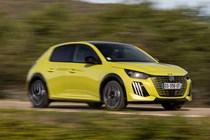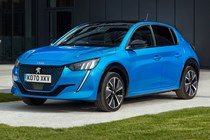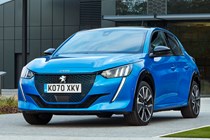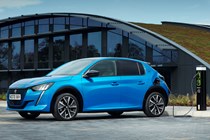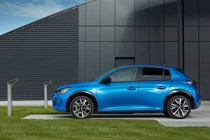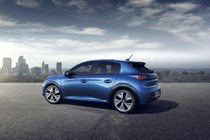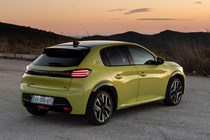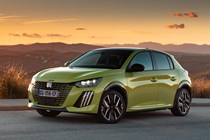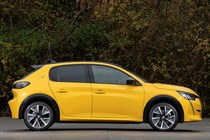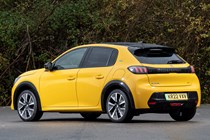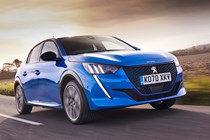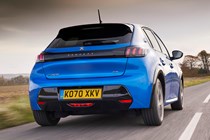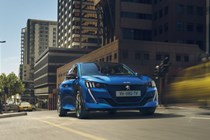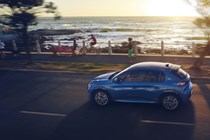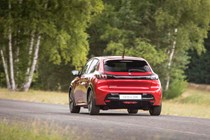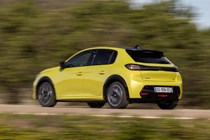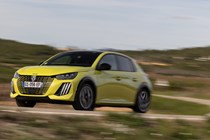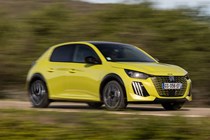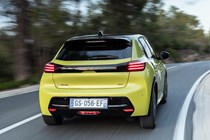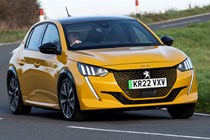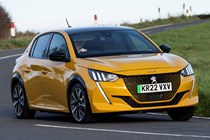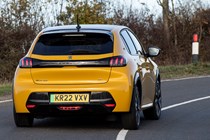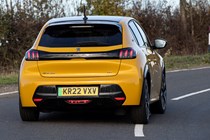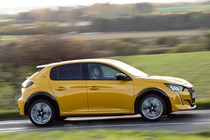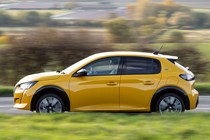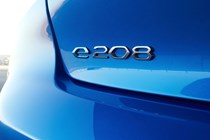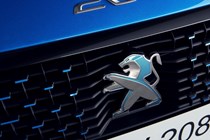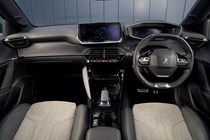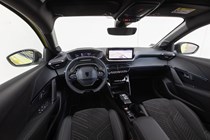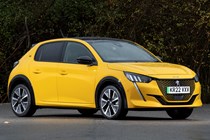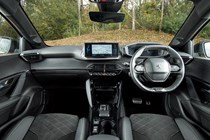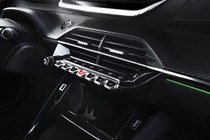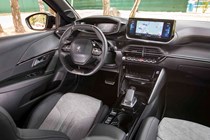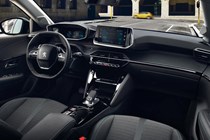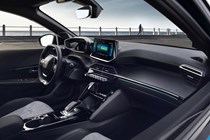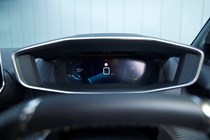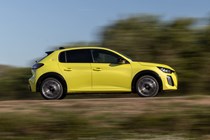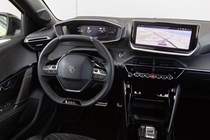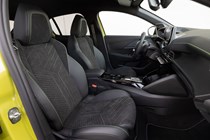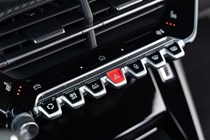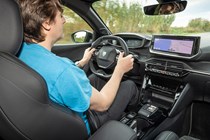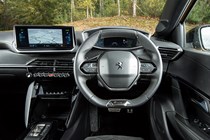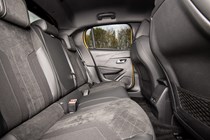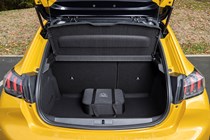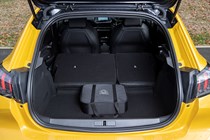
Peugeot e-208 boot space, practicality and safety
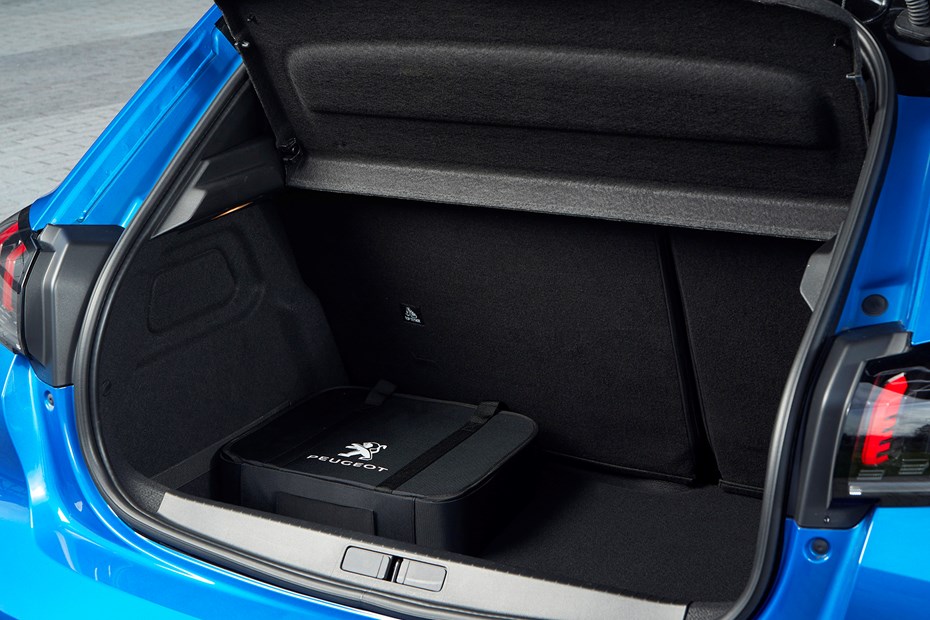
- Identical to combustion car
- Not overly spacious in the back
- Bootspace in the middle of its rivals
How much space is there?
Thanks to clever shared architecture the E-208’s battery is mounted below the floor. That means you don’t have to compromise any boot space or rear seat room when opting for the electric version.
That’s a good thing, as the regular 208 didn’t exactly have a lot of room to spare. The rear seats are rather tight, and a six-foot passenger will really struggle to sit behind a driver of the same height. Cut-outs in the front seatbacks help to boost leg room, but they’re made of hard plastic and aren’t the comfiest to rest your legs against.
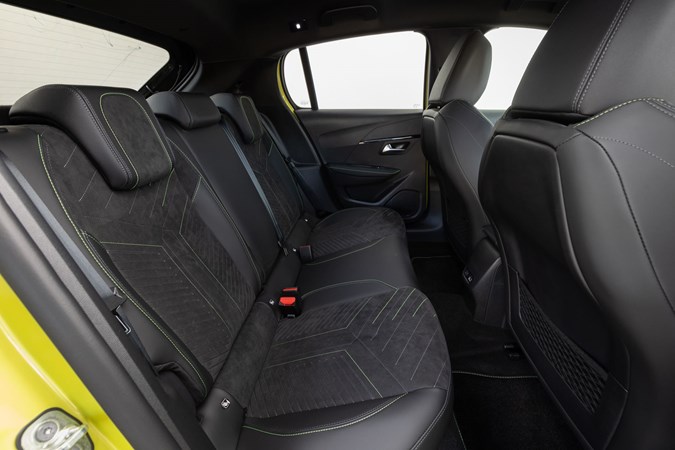
A Skoda Fabia or SEAT Ibiza offers much greater room for rear passengers – and you’ll find access easier with them, too. The E-208’s rear doors are rather small and square, making it more difficult to get in and out than it should be – and leaving a narrow aperture to load and secure a child seat, for example.
Boot space and storage
The E-208’s boot is 311 litres. That’s not the biggest on offer in the supermini segment – the champion being the Renault Clio and its palatial 395 litres – but it’s notably larger than the Ford Fiesta (292 litres) and the Toyota Yaris (286 litres). The rear seatbacks fold flat to liberate 1,106 litres of space. While they sit totally flat, they do leave a lip in the boot to haul things over.
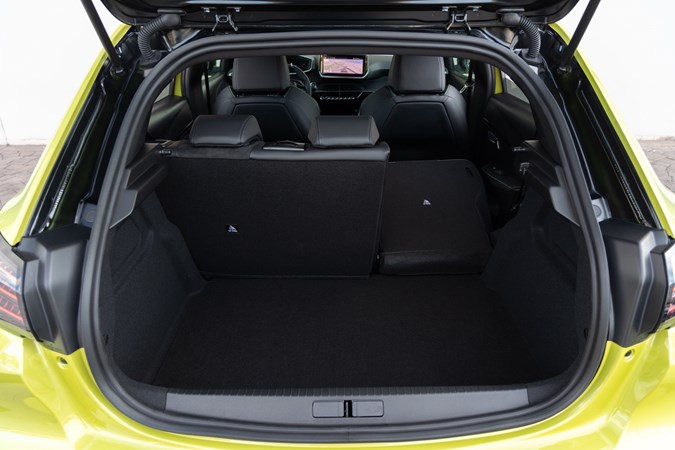
There are two small cubbies ahead of the gearlever, too – the upper one sits behind a fold-down cover, and contains a wireless charging pad for your phone on higher models. Even more cleverly, when the door is open, it has a lip that securely holds your phone where you can see it – ideal if you’re using navigation on your mobile device.
The door bins are well-sized too, but the glovebox – arguably the most important storage cubby – is tiny, due to Peugeot not re-siting the fuse box for right-hand drive cars.
Is it easy to park?
The E-208 is compact even for its class and visibility is reasonable, so you should be able to find plenty of spaces it will fit in.
All models get rear parking sensors, with a reversing camera included towards the top of the range.
Safety
- Four-star Euro NCAP rating
- Plenty of driver assistance tech
- Adaptive cruise works to a stop
The conventional Peugeot 208 received a four-star rating when crash tested by Euro NCAP in 2019 and comes with many passive and active safety systems, including airbags for the front passengers, curtain airbags and two Isofix points in the rear.
Standard equipment includes:
- Hill start assist
- Peugeot Connect SOS and assistance
- Programmable cruise control and speed limiter
- Lane keeping assist
- Speed limit recognition
- Driver attention warning
- Automatic headlights
- Autonomous braking with pedestrian detection
Identical practicality
Euro NCAP rating
| What is Euro NCAP? ⓘ | |
|---|---|
| Adult Occupant: | 91% |
| Child Occupant: | 86% |
| Vulnerable Road User: | 56% |
| Safety Assist: | 71% |
Equipment and options
- 3x3 point rear seat belts
- ABS
- Alarm
- Audio remote
- Driver`s airbag
- Electric mirrors
- Front electric windows
- Heated mirrors
- Height adjustable drivers seat
- Isofix child seat anchor points
- Metallic Paint
- PAS
- Passenger`s airbag
- Side airbags
- Steering wheel rake adjustment
- Steering wheel reach adjustment
- Climate control
- Cloth seat trim
- Cruise control
- Parking sensors
- Partial leather seat trim
- Steel wheels
- Air conditioning
- Rear electric windows
- Remote locking
- Air conditioning
- Alloy wheels
- Climate control
- Cloth seat trim
- Cruise control
- Parking sensors
- Partial leather seat trim
- Rear electric windows
- Remote locking
- Sat Nav
- Steel wheels
- n/a
- Air conditioning
- Alloy wheels
- Cloth seat trim
- Cruise control
- Parking sensors
- Partial leather seat trim
- Rear electric windows
- Remote locking
- n/a
- Air conditioning
- Climate control
- Cruise control
- Partial leather seat trim
- Rear electric windows
- Alloy wheels
- Parking sensors
- Remote locking
- Air conditioning
- Alloy wheels
- Climate control
- Cruise control
- Parking sensors
- Partial leather seat trim
- Rear electric windows
- Remote locking
- Sat Nav
- n/a
- Air conditioning
- Alloy wheels
- Cruise control
- Partial leather seat trim
- Rear electric windows
- Remote locking
- Sat Nav
- n/a
- Air conditioning
- Climate control
- Cruise control
- Partial leather seat trim
- Rear electric windows
- Remote locking
- Alloy wheels
- Parking sensors
- Sat Nav
- Alloy wheels
- Climate control
- Cruise control
- Partial leather seat trim
- Rear electric windows
- n/a
- Air conditioning
- Climate control
- Rear electric windows
- Remote locking
- Sat Nav
- Alloy wheels
- Electric driver`s seat
- Heated seats
- Lumbar support
- Parking sensors
- Partial leather seat trim
- Air conditioning
- Climate control
- Cruise control
- Partial leather seat trim
- Rear electric windows
- Remote locking
- Sat Nav
- Cloth seat trim
- Parking sensors
- Steel wheels
Dimensions
| Length | 4055mm |
|---|---|
| Width | 1960mm |
| Height | 1430mm |


